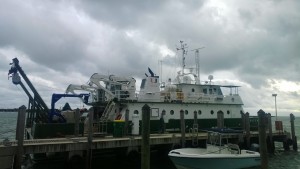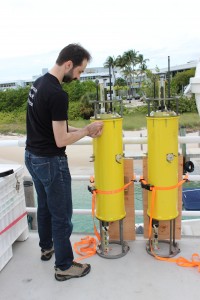
The Walton Smith, patiently awaiting departure.
Nathan Laxague
The LAgrangian Submesoscale ExpeRiment (LASER, for those following at home) kicked off not with a bang, but a whimper. At the time of this writing, the R/V F.G. Walton Smith is somewhere off the middle Keys, dressed to the nines with fancy scientific equipment and filled with the scientists and crew who weathered driving rain, whipping hail (!), and ominously rough seas to put it there. The next few days, though spent at sea, will be largely used for preparation and waiting. The task before those of us on board is at once familiar and uncertain. Those who followed the progress of the Walton Smith during 2012’s famed (in certain circles) Grand LAgrangian Deployment will recall its unwavering focus on the careful release GPS-tracked surface drifters into the waters surrounding the former Deepwater Horizon location.
In a way, LASER will pick up where GLAD left off: the so-called Phase One of LASER will include the near-simultaneous release of ~300 GPS-tracked surface drifters. Among the key differences between the two experiments: in the winter season, the sea’s mixed layer is deeper, allowing for upper-ocean motions fundamentally distinct from their summertime relatives that offer to fill the data coffers with new and exciting information about how water moves. In GLAD, the drifters were of a venerable, if aging design and constructed from good, old-fashioned American PVC. The LASER drifters were custom-designed based on multitudes of laboratory and field studies and represent a new frontier in oceanographic instrumentation with their injection-molded bioplastic bodies. The idea: yield valuable, synoptic observations of near-surface ocean current without leaving hundreds (or thousands) of plastic skeletons as CARTHE calling cards.
But, just like the mixed layer these new roving detectives will ride upon, the scope of LASER will far deeper than that of GLAD. Phases Two and Three of the experiment will include drifter and airborne photography-tracked drift card (for the purposes of this blog, think of them like drifters that we can sample on-site faster and with higher spatial precision) deployments targeted around submesoscale fronts and other such features. Put another way, LASER will build on the statistics-oriented GLAD by attempting to unpack the specific physical processes at play in upper-ocean dynamics. Combine these painstakingly-forged deployment strategies with a heavy and expensive cadre of shipboard and autonomous sensors and you have an experiment that exceeds its predecessor’s scale and dimensions.
With regard to the hinted-at ‘other’ observation methods and platforms, specifics will come as appropriate. But here’s an hors d’oeuvre (as if prepared by ship galley-master Peter):

Surface-following autonomous platforms stocked with instruments that sample at the very troughs of the marine-atmospheric boundary layer and dig at fundamental air-sea interaction questions.

Variably-buoyant, 3D Lagrangian drifters which add depth (and a sweet sensor suite) to the picture of upper-ocean dynamics.

An automated moving vessel profiler, allowing the collection of vertical salinity and temperature data even as the ship moves at maximum steam (offering an entirely new dimension as compared to traditional wake-up-at-2-in-the-morning-and-wear-a-hard-hat-for-15-minutes-as-an-unwieldy-behemoth-on-a-slow-winch-gathers-one-point-of-data method of shipboard CTD casting).

A whole host of bow-mounted, bolted-down flux and wave-measuring sensors. This area is still under construction but is quite operational (much like the Death Star 2 in Return of the Jedi).
Nathan Laxague, signing off somewhere between excitement and nervousness.
